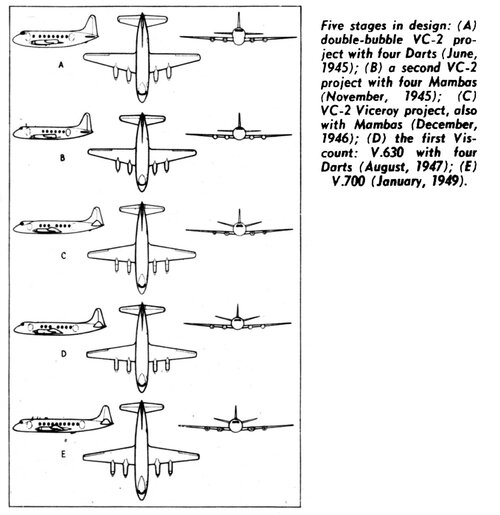You are using an out of date browser. It may not display this or other websites correctly.
You should upgrade or use an alternative browser.
You should upgrade or use an alternative browser.
Vickers type designations
- Thread starter Jos Heyman
- Start date
- Joined
- 26 May 2006
- Messages
- 34,885
- Reaction score
- 15,748
The letter combination VC (for Vickers Commercial) was only used for marketing purposes and was used as follows:
VC-1 Viking
VC-2 Viscount
VC-3 Proposed civilian development of the Varsity
VC-4 A three engined airliner for the North Atlantic route
VC-5 A long range transport based on the Valiant
VC-6 A short range transport based on the Valiant
VC-7 The 1000 design
VC-8 Viscount 800 series (?)
VC-9 Vanguard
VC-10 The VC-10
VC-11 A short range version of the VC-10
VC-12 Short range transport
In details,
Vickers & BAC
www.vc10.net
Attachments
Maveric
Fight for yor Right!
- Joined
- 14 January 2007
- Messages
- 2,231
- Reaction score
- 853
I would very much like to doubt this numbering. The Vickers Vernon dates from 1921. As early as 1913, Vickers assigned the designation Type 18 to the EFB.1. Here is the Type 18, the Vickers Viking III dates from 1920. The Viking IV is called Type 54 (1921). The jump would be too big.
- Joined
- 19 October 2012
- Messages
- 1,981
- Reaction score
- 1,932
I agree, Lumsden's numbering makes little sense.
- Joined
- 19 October 2012
- Messages
- 1,981
- Reaction score
- 1,932
- Joined
- 25 June 2009
- Messages
- 14,748
- Reaction score
- 6,116
Coming back to this topic after several years...
I would very much like to doubt this numbering. The Vickers Vernon dates from 1921. As early as 1913, Vickers assigned the designation Type 18 to the EFB.1. Here is the Type 18, the Vickers Viking III dates from 1920. The Viking IV is called Type 54 (1921). The jump would be too big.
I agree, too. That being said, I still have my doubts as to whether the early numbering system is connected to the one used from Type 50 onwards... Considering the E.F.B.3 of 1914 is said to have been Type 30, it means there would have been only 19 slots remaining for all the types created between then and 1920!I agree, Lumsden's numbering makes little sense.
- Joined
- 25 June 2009
- Messages
- 14,748
- Reaction score
- 6,116
we are now left with the following ‘unknown’ Types for the 1920s
53 | 65 | 90 | 101 | 109 | 126 | 136 | 152 | 154
In Morgan and Meerkom’s book of Air Ministry specifications there is this sketch drawing of a Vickers project to spec. 9/23 which would therefore date to late 1923. That makes it a possible contender to be Type 90. It is an odd design, parts are typical Vickers while others are unusual. It would be useful to see the original company drawings so before I start hunting has anyone more information.
- Regarding Type 90, I personally considered the Day Bombing Landplane (Drawing N°9047) designed to Spec. 10/23 to be a likely candidate.
- As for Type 126, I have it as the Vixen VI, [G-EBEC], a former type 105 re-engined and converted as a general purpose biplane. I can't say where I got that from. Note that there is also a Type 124 Vixen VI.
- Joined
- 25 June 2009
- Messages
- 14,748
- Reaction score
- 6,116
Source?the FB-5 = Type-32
- Joined
- 26 May 2006
- Messages
- 34,885
- Reaction score
- 15,748
Kites, Birds & Stuff - Vickers Aircraft - BY P. D. StempSource?
Similar threads
-
-
-
Renard Aircraft Designations (Belgium - including R.S.V. & Stampe et Renard)
- Started by Cy-27
- Replies: 19
-
-



